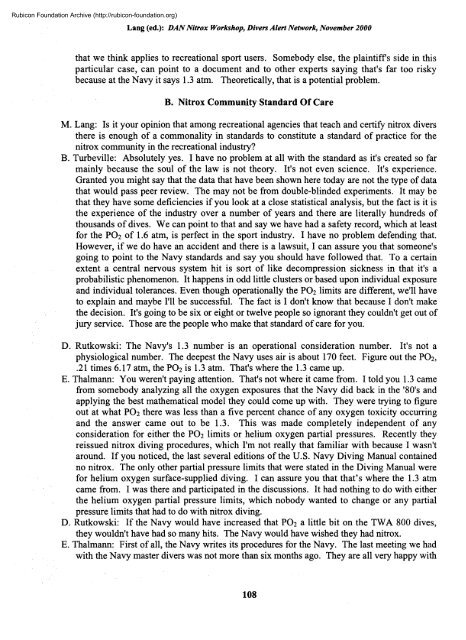Nitrox workshop dings - Divers Alert Network
Nitrox workshop dings - Divers Alert Network
Nitrox workshop dings - Divers Alert Network
You also want an ePaper? Increase the reach of your titles
YUMPU automatically turns print PDFs into web optimized ePapers that Google loves.
Rubicon Foundation Archive (http://rubicon-foundation.org)Lang (ed.): DAN<strong>Nitrox</strong> Workshop, <strong>Divers</strong> <strong>Alert</strong> <strong>Network</strong>, November 2000that we think applies to recreational sport users. Somebody else, the plaintiffs side in thisparticular case, can point to a document and to other experts saying that's far too riskybecause at the Navy it says 1.3 atm. Theoretically, that is a potential problem.B. <strong>Nitrox</strong> Community Standard Of CareM. Lang: Is it your opinion that among recreational agencies that teach and certify nitrox diversthere is enough of a commonality in standards to constitute a standard of practice for thenitrox community in the recreational industry?B. Turbeville: Absolutely yes. I have no problem at all with the standard as it's created so farmainly because the soul of the law is not theory. It's not even science. It's experience.Granted you might say that the data that have been shown here today are not the type of datathat would pass peer review. The may not be from double-blinded experiments. It may bethat they have some deficiencies if you look at a close statistical analysis, but the fact is it isthe experience of the industry over a number of years and there are literally hundreds ofthousands of dives. We can point to that and say we have had a safety record, which at leastfor the PO2 of 1.6 atm, is perfect in the sport industry. I have no problem defending that.However, if we do have an accident and there is a lawsuit, I can assure you that someone'sgoing to point to the Navy standards and say you should have followed that. To a certainextent a central nervous system hit is sort of like decompression sickness in that it's aprobabilistic phenomenon. It happens in odd little clusters or based upon individual exposureand individual tolerances. Even though operationally the PO2 limits are different, we'll haveto explain and maybe I'll be successful. The fact is I don't know that because I don't makethe decision. It's going to be six or eight or twelve people so ignorant they couldn't get out ofjury service. Those are the people who make that standard of care for you.D. Rutkowski: The Navy's 1.3 number is an operational consideration number. It's not aphysiological number. The deepest the Navy uses air is about 170 feet. Figure out the PO2,.21 times 6.17 atm, the PO2 is 1.3 atm. That's where the 1.3 came up.E. Thalmann: You weren't paying attention. That's not where it came from. I told you 1.3 camefrom somebody analyzing all the oxygen exposures that the Navy did back in the '80's andapplying the best mathematical model they could come up with. They were trying to figureout at what PO2 there was less than a five percent chance of any oxygen toxicity occurringand the answer came out to be 1.3. This was made completely independent of anyconsideration for either the PO2 limits or helium oxygen partial pressures. Recently theyreissued nitrox diving procedures, which I'm not really that familiar with because I wasn'taround. If you noticed, the last several editions of the U.S. Navy Diving Manual containedno nitrox. The only other partial pressure limits that were stated in the Diving Manual werefor helium oxygen surface-supplied diving. I can assure you that that's where the 1.3 atmcame from. I was there and participated in the discussions. It had nothing to do with eitherthe helium oxygen partial pressure limits, which nobody wanted to change or any partialpressure limits that had to do with nitrox diving.D. Rutkowski: If the Navy would have increased that PO2 a little bit on the TWA 800 dives,they wouldn't have had so many hits. The Navy would have wished they had nitrox.E. Thalmann: First of all, the Navy writes its procedures for the Navy. The last meeting we hadwith the Navy master divers was not more than six months ago. They are all very happy with108
















